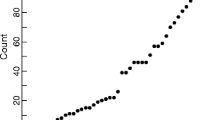Abstract
Populations of Iridaea splendens at Brockton Point, Stanley Park, Vancouver, Canada were observed to alternate in dominance between the gametophytic phase in summer and tetrasporophytic phase in winter. The mechanism regulating this alternation is not clear. Using a matrix projection model to simulate population growth, we show that this alternation is possible if there are differential survival and recruitment rates of the two phases in summer and winter. Sensitivity and elasticity analyses indicate the relative importance of perennation vs. recruitment. Recruitment from tetrasporophytes and from gametophytes both contribute about 25% to the population growth. Perennation among gametophytes is more important than among tetrasporophytes. The implication of this is that if this population is to be harvested, more tetrasporophytes can be harvested than gametophytes without resulting in the depletion of the resource. This is simulated in the matrix model by comparing the relative effects on population growth of increasing the mortality rate of the perennation phase of tetrasporophyte and gametophyte by 50 to 75%, and increasing recruitment rate in either phase, from summer to winter or from winter to summer.
Similar content being viewed by others
References
Ang, P., Jr. & R. E. De Wreede, 1990. Matrix models for algal life history stages. Mar. Ecol. Prog. Ser. 59: 171–181.
Caswell, H., 1986. Matrix models and the analysis of complex plant life. Lect. Math. Life Sciences 18: 171–233.
Green, L. G., 1989. Life history stage ratios of Iridaea cordata and factors controlling these ratios in intertidal populations. M. Sc. thesis, University of British Columbia, Vancouver, Canada, 143 p.
Green, L. G. & R. E. De Wreede, 1990. Patterns of gametophyte dominance of Iridaea splendens (Rhodophyta) in Vancouver Harbour, Vancouver, British Columbia, Canada. J. appl. Phycol. 2: 27–34.
Mumford, T. F., Jr. & J. R. Waaland, 1980. Progress and prospects for field cultivation of Iridaea cordata and Gigartina exasperata. In I. A. Abbott, M. S. Foster & L. F. Eklund (eds), Pacific Seaweed Aquaculture. The California Sea Grant College Program, La Jolla, California: 92–105, 192–197, 213–228.
Author information
Authors and Affiliations
Additional information
Dedicated to Dr T. Bisalputra of the University of British Columbia on the occasion of his retirement.
Rights and permissions
About this article
Cite this article
Ang, P., De Wreede, R.E., Shaughnessy, F. et al. A simulation model for an Iridaea splendens (Gigartinales, Rhodophyta) population in Vancouver, Canada. Hydrobiologia 204, 191–196 (1990). https://doi.org/10.1007/BF00040233
Issue Date:
DOI: https://doi.org/10.1007/BF00040233




